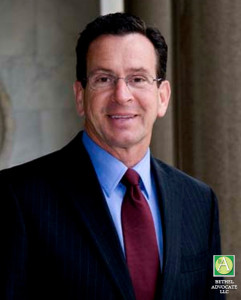
Report by Paula Antolini
February 8, 2017 7:10PM EDT
Gov. Malloy Introduces Budget Proposal Focused on Making State Economy More Predictable and More Sustainable
Proposes $1.3 Billion in State Spending Reductions, Asks for $700 Million in Annual Labor Savings
(HARTFORD, CT) – Governor Dannel P. Malloy today submitted his Fiscal Year 2018/2019 biennial budget proposal to the state legislature that was designed to encourage fiscal stability and predictability for Connecticut residents and businesses while building on the progress made in recent years to reduce spending, bolster our economy, and grow jobs.
The Governor is calling for a two-year budget that does not make adjustments to any major tax rates, stays within the spending cap, and grows at a pace well below inflation. Containing $1.36 billion in new spending reductions, the proposal re-envisions state government in order to provide essential, core services at a less cost to taxpayers.
“Together let’s ensure that all Connecticut communities see their fair share of success,” Governor Malloy told lawmakers during his budget address. “Let’s give taxpayers, communities, and businesses more predictability and more sustainability. Let’s have the courage to collectively tackle the challenge of inequity in town aid. Let’s do it so that ten years from now, no Connecticut city or town needs to levy a mil rate of 35 or more. As we negotiate this budget, we should remember that we are in this together. It’s about more than just how my town or my community or my family did. It’s also about neighboring towns, neighboring communities, and neighboring families, as well. We will rise or fall together, as one Connecticut. And working together, I know we will prevail.”
Key elements of the proposal include:
- Stays below the spending cap and grows at a pace well below inflation, all while making required increased contributions to our pension systems of more than $357 million.
- Keeps state budget at an eight-year growth rate of only 2 percent – compared to the previous eight years which grew at a rate of 4.8 percent.
- Calls for $700 million in annual state employee labor savings.
- Lowers the tax rate on insurance premiums from the current rate of 1.75 percent down to 1.5 percent.
- Updates the Education Cost Sharing (ECS) formula for towns and cities to provide a more equitable, transparent, and fair method of funding the state’s education system. The new formula recognizes shifting demographics in small towns and growing cities, and uses a more accurate measure of wealth, allowing the state to better direct support to communities with higher concentrations of poverty.
- Increases funding for Special Education by $10 million and makes it a separate formula grant from ECS to provide more transparency in the actual costs and encouraging school systems to seek Medicaid reimbursement where available in order to ensure that no communities leave federal dollars on the table.
- Asks towns to contribute to the costs of their employees’ pensions. Currently, the state pays 100 percent of the employer contribution to the Teachers’ Retirement System – this proposal ask the municipalities for which they worked to contribute a portion of those costs.
- Includes substantial state mandate relief for towns and cities across Connecticut, providing municipalities with greater flexibility and additional tools for making local government leaner and more cost efficient.
- Creates a municipal accountability system designed to provide state intervention and support to local governments confronting fiscal challenges.
The Governor noted that even as spending is being cut, many important things are preserved in the budget including:
- Putting millions of dollars toward helping Connecticut’s chronically unemployed get back on their feet and back to work.
- Fully funding our critical arts and tourism awards.
- Helping the Connecticut Department of Housing fulfill its mission of matching every single chronically homeless person to permanent housing (the first state in the nation to do it!).
- Funding new technology for law enforcement that will help keep crime at historic lows.
- Redeveloping brownfields in every corner of the state, turning blighted properties into economic opportunities.
- Supporting people with intellectual disabilities, with $3.8 million in new funding.
- Keeping Connecticut’s beautiful state parks open and available to all.
Click here to view Governor’s Fiscal Year 2018/2019 proposed budget.
Click here to view Governor Dannel P. Malloy’s Fiscal Year 2018 – 2019 Biennial Budget Address.
###


